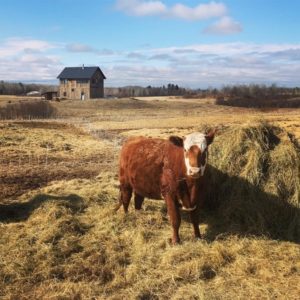Some Benefits of Bale Grazing
Pockets of hay remained after the snow melted away, golden-brown knolls in the green sea of early spring grass. The sheep and cattle stood in the last of their winter paddocks, monoliths of round bales in various stages of collapse as they’re rent apart by hungry mouths.
Hannah Bernhardt, of Medicine Creek Farm near Finlayson, Minnesota, explains how she rotates her livestock through hay-filled paddocks in the winter.
In the fall, she strategically pre-sets all the bales based on where she wants the animals to be at different points in the season. Sometimes that means proximity to water sources, sometimes that means avoiding low and muddy spots when the weather warms. Right now, they are near the house for shearing before soon moving out to begin lambing on pasture.
Usually, Hannah simply spreads any leftover hay with her feet, kicking it around as she does chores. Pointing to two big bales the sheep refused to finish eating before moving on, she acknowledges that sometimes there’s too much to do manually, but it won’t decompose well in a mound like that.
“I’ll grab those and move them to the pigs for bedding. Otherwise, I prefer to wait [and let hay break down in place].”
Bale grazing can be a contentious topic. Some oppose the practice entirely, viewing it as a waste of forage. But for Hannah, the benefits to soil health outweigh the expense of extra hay.
She sees life in the soil increasing year by year. After a year of bale grazing, bale remnants break down faster, and those spots are a deeper green and stay vegetative longer than surrounding areas.
Whenever sheep escape, they make a beeline to graze on those specific patches of dark green grass where the bales had been. And the extra water retention has gotten her through drought. When nothing else was growing this area stayed green and Hannah says “it basically kept me grazing that year.”
She also assumes that what bit of hay the animals leave behind is lower quality anyway, so it is better off amending the soil than taking up space in the animal.
Many farmers who bale graze unroll the bale in one long strip for livestock to graze. Hannah acknowledges that it would spread out the nutrient distribution, probably result in less waste, and speed up their breakdown, but there are a few reasons she leaves them in place.
First, she’d rather not turn on the tractor every day, preferring to avoid the added expense.
Second, unrolling bales in the winter can be unfeasible. Sometime the snow is so deep Hannah wouldn’t be able to unroll even if she wanted to. Snow depth is also why she doesn’t limit access to bales in the paddocks – the snow prevents the fence from grounding adequately and the animals just push through to whatever bale they want.
Hannah has adapted to make it work. “Mostly, I follow them around and open the next bale that they’ve started.”
And finally, Hannah simply likes the visual evidence of the bale’s positive effect on the soil. “[With unrolling] you don’t see the single dramatic spot. I find it really satisfying.”



